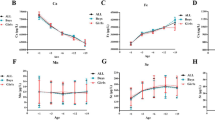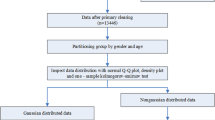Abstract
The short stature in children is defined as height below the third percentile from the mean for age and gender. This problem affects about 3 % of young people. More than 20,000 children in Poland have problems with short stature. There is not much information available in the literature on the study of metals in blood, plasma, and urine in children with short stature. The study was conducted on a group of 56 short stature Polish children and 35 healthy children. The content of metals was determined using high-performance ion chromatography and inductively coupled plasma mass spectrometry methods. The study revealed significant differences between the content of selected metals in body fluids between a short stature group and healthy children. There were significant differences in the Fe, Cu, and Ni concentrations between the groups with respect to the hormonal therapy. There were no significant differences between the groups with respect to the area where the children lived. The results showed no statistically significant differences between metal concentration and age, body weight, and height. The study demonstrated statistically significant differences between the content of metals in body fluids in short stature children compared with the healthy children. It seems that the difference in the concentration of certain elements may also be the result of growth hormone therapy and the interaction between various metals. Both the alterations in the content of metals and their mutual interactions may play an important role in the pathogenesis of short stature children.
Similar content being viewed by others
References
Romer TE, Walczak M, Wiśniewski A et al (2001) Children with growth disorders qualified in Poland for growth hormone therapy. Pediatr Prakt 9:41–54
Wit J, Clayton P, Rogol A et al (2008) Idiopathic short stature: definition, epidemiology, and diagnostic evaluation. Growth Hormon IGF Research 18:89–110
Dattani M, Preece M (2004) Growth hormone deficiency and related disorders: insights into causation, diagnosis, and treatment. Lancet 363:1977–1987
Sultan M, Afzal M, Qureshi SM et al (2008) Etiology of short stature in children. J Coll Physicians Surg Pak 8:493–497
Ruz M (2006) Zinc supplementation and growth. Curr Opin Clin Nutr Metab Care 9:757–762
Uriu-Adams JY, Keen CL (2010) Zinc and reproduction: effects of zinc deficiency on prenatal and early postnatal development. Birth Defects Res B Dev Reprod Toxicol 89:313–325
Cayir A, Doneray H, Kurt N et al (2014) Thyroid functions and trace elements in pediatric patients with exogenous obesity. Biol Trace Elem Res 157:95–100. doi:10.1007/s12011-013-9880-8
Błażewicz A, Orlicz-Szczęsna G, Prystupa A et al (2010) Use of ion chromatography for the determination of selected metals in blood serum of patients with type 2 diabetes. J Trace Elem Med Biol 24:14–19
Błażewicz A, Klatka M, Astel A, Partyka M et al (2013) Differences in trace metal concentrations (Co, Cu, Fe, Mn, Zn, Cd, and Ni) in whole blood, plasma, and urine of obese and nonobese children. Biol Trace Elem Res 155:190–200
Astel A, Sărbu C, Biziuk M (2009) Hard tissue samples as markers of occupational exposure in phosphatic fertilizer plant. Int J Environ Health 3:1–21
Frieberg L, Nordberg GF, Vouk V (1986) Handbook on the toxicology of metals, 2nd ed. Volume 1: general aspects. Elsevier, Amsterdam
Błażewicz A, Baj T, Świeboda R et al (2007) Determination of heavy metals in aerial part of hyssop (Hyssopus officinalis L.) using high performance ion chromatography with the aid of a linear and non-linear weighted least-squares regression model. Pol J Environ Stud 16:191–198
Ploysangam A, Falciglia GA, Brehm BJ (1997) Effect of marginal zinc deficiency on human growth and development. J Trop Pediatr 43:192–198
Prasad AS (2008) Clinical, immunological, anti-inflammatory and antioxidant roles of zinc. Exp Gerontol 43:370–377
Castillo-Duran C, Garcia H, Venegas P et al (1994) Zinc supplementation increases growth velocity of male children and adolescents with short stature. Acta Paediatr 83:833–837
Paniagua-Castro N, Escalona-Cardoso G, Madrigal-Bujaidar E et al (2008) Protection against cadmium-induced teratogenicity in vitro by glycine. Toxicol In Vitro 22:75–79
Kippler M, Tofail F, Gardner R et al (2012) Maternal cadmium exposure during pregnancy and size at birth: a prospective cohort study. Environ Health Perspect 120:284–289. doi:10.1289/ehp.1103711
Díaz Gómez NM, Doménech Martínez E, Barroso Guerrero F (1996) Trace elements and growth factors in the perinatal period. An Esp Pediatr 44:351–356
Szakmáry E, Ungváry G, Hudák A et al (2001) Effects of cobalt sulfate on prenatal development of mice, rats, and rabbits, and on early postnatal development of rats. J Toxicol Environ Health A 62:367–386
Anke M, Groppel B, Kronemann H et al (1994) Nickel—an essential element. IARC Sci Publ 53:339–365
Wood RJ (2009) Manganese and birth outcome. Nutr Rev 67:416–420
Klevay LM (2014) Copper and public health: dietary intakes vs. clinical data. J Trace Elem Med Biol 28:354
Gambling L, Danzeisen R, Fosset C (2003) Iron and copper interactions in development and the effect on pregnancy outcome. J Nutr 133(Suppl 1):1554S–1556S
Zaddik Z, Sinai T, Zung A et al (2005) Effect of nutrition on growth in short stature before and during growth-hormone therapy. Pediatrics 116:68–72
Zheng J, Mao X, Ling J et al (2014) Low serum levels of zinc, copper, and iron as a risk factor for osteoporosis: a meta- analysis. Biol Trace Elem Res 160:15–23. doi:10.1007/s12011-014-0031-7
Solans CV, Lifshitz F (1992) Body weight progression and nutritional status of patients with familial short stature with and without constitutional delay in growth. Am J Dis Child 146:296–302
Conflict of Interest
The authors declare that they have no conflict of interest.
Ethical Approval
All procedures performed in studies involving human participants were in accordance with the ethical standards of the institutional and/or national research committee and with the 1964 Helsinki declaration and its later amendments or comparable ethical standards.
Informed Consent
Additional informed consent was obtained from all individual participants for whom identifying information is included in this article.
Author information
Authors and Affiliations
Corresponding author
Rights and permissions
About this article
Cite this article
Klatka, M., Błażewicz, A., Partyka, M. et al. Concentration of Selected Metals in Whole Blood, Plasma, and Urine in Short Stature and Healthy Children. Biol Trace Elem Res 166, 142–148 (2015). https://doi.org/10.1007/s12011-015-0262-2
Received:
Accepted:
Published:
Issue Date:
DOI: https://doi.org/10.1007/s12011-015-0262-2




